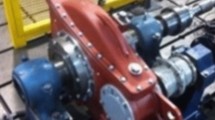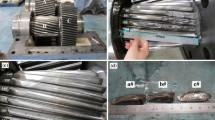Abstract
In this study, a comprehensive finite-element-based method, utilizing the continuum damage mechanics (CDM) theory and the linear elastic fracture mechanics (LEFM) theory, is proposed to predict the total gear bending fatigue life including the crack initiation and propagation. The developed gear finite element model has been validated following the ISO standard result. The contribution of crack propagation to the overall lifetime is addressed. Simulated results indicate that the gear bending fatigue life, especially the crack initiation life, highly depends on the loading level. In addition, the gear bending fatigue crack initiation life dominates the total life.

















Similar content being viewed by others
References
Lewis W (1958) Investigation of the strength of gear teeth In Proceedings of Engineers Club, Philadelphia, Vol 1893. pp. 19–23
Handschuh MJ, Kahraman A, Milliren MR (2014) Impact of tooth spacing errors on the root stresses of spur gear pairs. J Mech Des 136:061010
Lisle TJ, Shaw BA, Frazer RC (2017) External spur gear root bending stress: a comparison of ISO 6336: 2006, AGMA 2101–D04, ANSYS finite element analysis and strain gauge techniques. Mech Mach Theory 111:1–9
Lisle TJ, Shaw BA, Frazer RC (2019) Internal spur gear root bending stress: A comparison of ISO 6336:1996, ISO 6336:2006, VDI 2737:2005, AGMA, ANSYS finite element analysis and strain gauge techniques In Proceedings of the Institution of Mechanical Engineers Part C—Journal of Mechanical Engineering Science, 233:1713–1720
Liu S, Song C, Zhu C, Liang C, Bai H (2020) Investigation on contact and bending stress of face-hobbed and face-milled hypoid gear. Mech Mach Theory 150:103873
Lin C, Li P, Liu W (2020) Analysis and calculation of bending fatigue life of curve-face gear. J Braz Soc Mech Sci Eng 42:1–11
Cular I, Vuckovic K, Glodez S, Tonkovic Z (2022) Computational model for bending fatigue prediction of surface hardened spur gears based on the multilayer method. Int J Fatigue 161:106892
Cular I, Vuckovic K, Zezelj D, Glodez S (2020) Analytical approach for low and high cycle bending fatigue life prediction of carburized gear steel specimens. Eng Fail Anal 108:104328
Vuckovic K, Galic I, Bozic Z, Glodez S (2018) Effect of friction in a single-tooth fatigue test. Int J Fatigue 114:148–158
Kramberger J, Sraml M, Potrc I, Flasker J (2004) Numerical calculation of bending fatigue life of thin-rim spur gears. Eng Fract Mech 71:647–656
Kramberger J, Sraml M, Glodez S, Flasker J, Potrc I (2004) Computational model for the analysis of bending fatigue in gears. Comput Struct 82:2261–2269
Ghaffari MA, Pahl E, Xiao SP (2015) Three dimensional fatigue crack initiation and propagation analysis of a gear tooth under various load conditions and fatigue life extension with boron/epoxy patches. Eng Fract Mech 135:126–146
Lin YL, Liu SR, Zhao, Mao ER, Cao C, Suh CS (2018) Fatigue life prediction of engaging spur gears using power density In Proceedings of the Institution of Mechanical Engineers Part C—Journal of Mechanical Engineering Science. 232:4332–4341
Deng H, Guo Y, Liu H, Liu Q, Guo Y, Yu H (2022) Bending fatigue life prediction model of carburized gear based on microcosmic fatigue failure mechanism. J Mater Eng Perform 31:882–894
He H, Liu H, Zhu C, Wei P, Tang J (2019) Study on the gear fatigue behavior considering the effect of residual stress based on the continuous damage approach. Eng Fail Anal 104:531–544
He H, Liu H, Zhu C, Wei P, Tang J (2020) Analysis on fatigue crack initiation of a wind turbine gear considering load sequence effect. Int J Damage Mech 29:207–225
Lorenz SJ, Sadeghi F, Trivedi HK, Rosado L, Kirsch MS, Wang C (2021) A continuum damage mechanics finite element model for investigating effects of surface roughness on rolling contact fatigue. Int J Fatigue 143:105986
Vijay A, Paulson N, Sadeghi F (2018) A 3D finite element modelling of crystalline anisotropy in rolling contact fatigue. Int J Fatigue 106:92–102
Singh K, Sadeghi F, Correns M, Blass T (2019) A microstructure based approach to model effects of surface roughness on tensile fatigue. Int J Fatigue 129:105229
Warhadpande A, Jalalahmadi B, Slack T, Sadeghi F (2010) A new finite element fatigue modeling approach for life scatter in tensile steel specimens. Int J Fatigue 32:685–697
Hojjati-Talemi R, Wahab MA, Giner E, Sabsabi M (2013) Numerical estimation of fretting fatigue lifetime using damage and fracture mechanics. Tribol Lett 52:11–25
Shen F, Ke L-L, Zhou K (2021) A debris layer evolution-based model for predicting both fretting wear and fretting fatigue lifetime. Int J Fatigue 142:105928
Lewicki DG, Ballarini R (1997) Effect of rim thickness on gear crack propagation path. J Mech Des 119:88–95
Lewicki DG, Handschuh RF, Spievak LE, Wawrzynek PA, Ingraffea AR (2001) Consideration of moving tooth load in gear crack propagation predictions. J Mech Des 123:118–124
Glodez S, Pehan S, Flasker J (1998) Experimental results of the fatigue crack growth in a gear tooth root. Int J Fatigue 20:669–675
Yan H, Wei P, Zhou P, Chen L, Liu H, Zhu C (2022) Experimental investigation of crack growth behaviors and mechanical properties degradation during gear bending fatigue. J Mech Sci Technol 36:1233–1242
Bozic Z, Schmauder S, Wolf H (2018) The effect of residual stresses on fatigue crack propagation in welded stiffened panels. Eng Fail Anal 84:346–357
Bozic Z, Schmauder S, Mlikota M, Hummel M (2014) Multiscale fatigue crack growth modelling for welded stiffened panels. Fatigue Fract Eng Mater Struct 37:1043–1054
Kratzer D, Koller P, Tobie T, Stahl K (2022) Investigation of the effects of surface roughness and shot peening on the tooth root bending strength of case-carburized gears. J Mech Sci Technol 36:731–740
Fuchs D, Schurer S, Tobie T, Stahl K (2022) On the determination of the bending fatigue strength in and above the very high cycle fatigue regime of shot-peened gears. Forsch Ingenieurwesen Eng Research 86:81–92
Winkler KJ, Schurer S, Tobie T, Stahl K (2019) Investigations on the tooth root bending strength and the fatigue fracture characteristics of case-carburized and shot-peened gears of different sizes In Proceedings of the Institution of Mechanical Engineers Part C—Journal of Mechanical Engineering Science 233:7338–7349
Cura F, Mura A, Rosso C (2015) Effect of rim and web interaction on crack propagation paths in gears by means of XFEM technique. Fatigue Fract Eng Mater Struct 38:1237–1245
Cura F, Mura A, Rosso C (2017) Influence of high speed on crack propagation path in thin rim gears. Fatigue Fract Eng Mater Struct 40:120–129
Zhao Z, Chu F (2018) Molecular dynamics simulation of crack initiation and propagation in bcc iron under load within spur gear tooth root. Fatigue Fract Eng Mater Struct 41:323–335
Podrug S, Jelaska D, GlodeZ S (2008) Influence of different load models on gear crack path shapes and fatigue lives. Fatigue Fract Eng Mater Struct 31:327–339
Lemaitre DRJ (2005) Engineering damage mechanics. Springer, Berlin Heidelberg Germany
Lundberg G, Palmgren A (1947) Dynamic capacity of rolling bearings. J Appl Mech Trans Asme 107:367–378
Ghodrati M, Ahmadian M, Mirzaeifar R (2018) Modeling of rolling contact fatigue in rails at the microstructural level. Wear 406–407:205–217
He H, Liu H, Zhu C, Wei P, Sun Z (2018) Study of rolling contact fatigue behavior of a wind turbine gear based on damage-coupled elastic-plastic model. Int J Mech Sci 141:512–519
ISO (2019) 6336–3 Calculation and load capacity of spur and helical gears-Part 3: calculation of tooth bending strength. International Organization for Standardization, Switzerland
Wen Q, Du QG, Zhai XC (2018) A new analytical model to calculate the maximum tooth root stress and critical section location of spur gear. Mech Mach Theory 128:275–286
Warhadpande A, Sadeghi F, Kotzalas MN, Doll G (2012) Effects of plasticity on subsurface initiated spalling in rolling contact fatigue. Int J Fatigue 36:80–95
Baldissera P (2009) Fatigue scatter reduction through deep cryogenic treatment on the 18NiCrMo5 carburized steel. Mater Des 30:3636–3642
Zhang T, McHugh PE, Leen SB (2012) Finite element implementation of multiaxial continuum damage mechanics for plain and fretting fatigue. Int J Fatigue 44:260–272
Bhattacharya B, Ellingwood B (1998) Continuum damage mechanics analysis of fatigue crack initiation. Int J Fatigue 20:631–639
Jin XQ, Keer LM, Chez EL (2006) Numerical simulation of growth pattern of a fluid-filled subsurface crack under moving hertzian loading. Int J Fract 142:219–232
He H, Liu H, Zhu C, Mura A (2021) Numerical study on fatigue crack propagation behaviors in lubricated rolling contact. Chin J Aeronaut 34:24–36
Shahani AR, Davachi R, Babaei M (2019) The crack propagation path under multiple moving contact loads in rolling contact fatigue. Theoret Appl Fract Mech 100:200–207
Li F, Hu W, Meng Q, Zhan Z, Shen F (2018) A new damage-mechanics-based model for rolling contact fatigue analysis of cylindrical roller bearing. Tribol Int 120:105–114
Jalalahmadi B, Sadeghi F (2010) A voronoi FE fatigue damage model for life scatter in rolling contacts. J Tribol 132:021404
Chen Y, Jin Y, Liang X, Kang R (2018) Propagation path and failure behavior analysis of cracked gears under different initial angles. Mech Syst Signal Process 110:90–109
Verma JG, Kumar S, Kankar PK (2018) Crack growth modeling in spur gear tooth and its effect on mesh stiffness using extended finite element method. Eng Fail Anal 94:109–120
Wang X, Yang Y, Wang W, Chi W (2020) Simulating coupling behavior of spur gear meshing and fatigue crack propagation in tooth root. Int J Fatigue 134:105381
Kujawski D, Ellyin F (1992) Crack initiation and total fatigue life of a carbon steel in vacuum and air. J Test Eval 20:391–395
Zhang X, Li L, Qi X, Zheng J, Chen B, Feng J, Duan S (2017) Experimental and numerical investigation of fatigue crack growth in the cracked gear tooth. Fatigue Fract Eng Mater Struct 40:1037–1047
Morris D, Sadeghi F, Chen Y-C, Wang C, Wang B (2019) Predicting material performance in rolling contact fatigue via torsional fatigue. Tribol Trans 62:614–625
Funding
This study was funded by the National Key R&D Program of China (No. 2020YFB2008200) and natural science foundation of Guizhou normal university (No. Qianshi2021B20).
Author information
Authors and Affiliations
Corresponding author
Ethics declarations
Conflict of interest
The authors declare that they have no conflict of interest.
Additional information
Publisher's Note
Springer Nature remains neutral with regard to jurisdictional claims in published maps and institutional affiliations.
Rights and permissions
Springer Nature or its licensor (e.g. a society or other partner) holds exclusive rights to this article under a publishing agreement with the author(s) or other rightsholder(s); author self-archiving of the accepted manuscript version of this article is solely governed by the terms of such publishing agreement and applicable law.
About this article
Cite this article
He, H., Liu, H., Mura, A. et al. Gear bending fatigue life prediction based on continuum damage mechanics and linear elastic fracture mechanics. Meccanica 58, 119–135 (2023). https://doi.org/10.1007/s11012-022-01622-5
Received:
Accepted:
Published:
Issue Date:
DOI: https://doi.org/10.1007/s11012-022-01622-5




